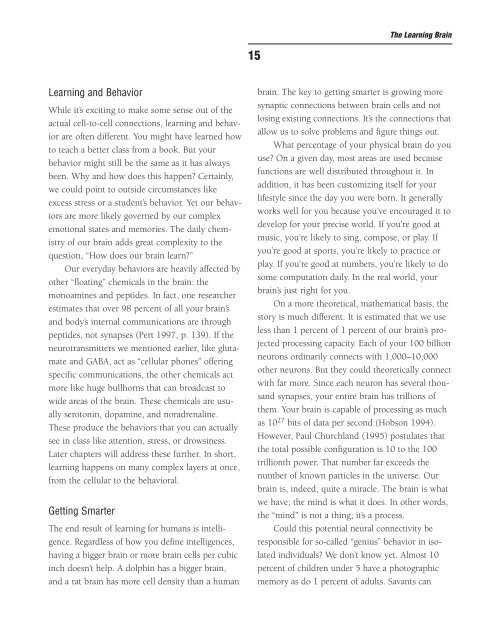Create successful ePaper yourself
Turn your PDF publications into a flip-book with our unique Google optimized e-Paper software.
Learn<strong>in</strong>g and Behavior<br />
While it’s excit<strong>in</strong>g to make some sense out of <strong>the</strong><br />
actual cell-to-cell connections, learn<strong>in</strong>g and behavior<br />
are often different. You might have learned how<br />
to teach a better class from a book. But your<br />
behavior might still be <strong>the</strong> same as it has always<br />
been. Why and how does this happen? Certa<strong>in</strong>ly,<br />
we could po<strong>in</strong>t to outside circumstances like<br />
excess stress or a student’s behavior. Yet our behaviors<br />
are more likely governed by our complex<br />
emotional states and memories. The daily chemistry<br />
of our bra<strong>in</strong> adds great complexity to <strong>the</strong><br />
question, “How does our bra<strong>in</strong> learn?”<br />
Our everyday behaviors are heavily affected by<br />
o<strong>the</strong>r “float<strong>in</strong>g” chemicals <strong>in</strong> <strong>the</strong> bra<strong>in</strong>: <strong>the</strong><br />
monoam<strong>in</strong>es and peptides. In fact, one researcher<br />
estimates that over 98 percent of all your bra<strong>in</strong>’s<br />
and body’s <strong>in</strong>ternal communications are through<br />
peptides, not synapses (Pert 1997, p. 139). If <strong>the</strong><br />
neurotransmitters we mentioned earlier, like glutamate<br />
and GABA, act as “cellular phones” offer<strong>in</strong>g<br />
specific communications, <strong>the</strong> o<strong>the</strong>r chemicals act<br />
more like huge bullhorns that can broadcast to<br />
wide areas of <strong>the</strong> bra<strong>in</strong>. These chemicals are usually<br />
seroton<strong>in</strong>, dopam<strong>in</strong>e, and noradrenal<strong>in</strong>e.<br />
These produce <strong>the</strong> behaviors that you can actually<br />
see <strong>in</strong> class like attention, stress, or drows<strong>in</strong>ess.<br />
Later chapters will address <strong>the</strong>se fur<strong>the</strong>r. In short,<br />
learn<strong>in</strong>g happens on many complex layers at once,<br />
from <strong>the</strong> cellular to <strong>the</strong> behavioral.<br />
Gett<strong>in</strong>g Smarter<br />
The end result of learn<strong>in</strong>g for humans is <strong>in</strong>telligence.<br />
Regardless of how you def<strong>in</strong>e <strong>in</strong>telligences,<br />
hav<strong>in</strong>g a bigger bra<strong>in</strong> or more bra<strong>in</strong> cells per cubic<br />
<strong>in</strong>ch doesn’t help. A dolph<strong>in</strong> has a bigger bra<strong>in</strong>,<br />
and a rat bra<strong>in</strong> has more cell density than a human<br />
15<br />
The Learn<strong>in</strong>g <strong>Bra<strong>in</strong></strong><br />
bra<strong>in</strong>. The key to gett<strong>in</strong>g smarter is grow<strong>in</strong>g more<br />
synaptic connections between bra<strong>in</strong> cells and not<br />
los<strong>in</strong>g exist<strong>in</strong>g connections. It’s <strong>the</strong> connections that<br />
allow us to solve problems and figure th<strong>in</strong>gs out.<br />
What percentage of your physical bra<strong>in</strong> do you<br />
use? On a given day, most areas are used because<br />
functions are well distributed throughout it. In<br />
addition, it has been customiz<strong>in</strong>g itself for your<br />
lifestyle s<strong>in</strong>ce <strong>the</strong> day you were born. It generally<br />
works well for you because you’ve encouraged it to<br />
develop for your precise world. If you’re good at<br />
music, you’re likely to s<strong>in</strong>g, compose, or play. If<br />
you’re good at sports, you’re likely to practice or<br />
play. If you’re good at numbers, you’re likely to do<br />
some computation daily. In <strong>the</strong> real world, your<br />
bra<strong>in</strong>’s just right for you.<br />
On a more <strong>the</strong>oretical, ma<strong>the</strong>matical basis, <strong>the</strong><br />
story is much different. It is estimated that we use<br />
less than 1 percent of 1 percent of our bra<strong>in</strong>’s projected<br />
process<strong>in</strong>g capacity. Each of your 100 billion<br />
neurons ord<strong>in</strong>arily connects with 1,000–10,000<br />
o<strong>the</strong>r neurons. But <strong>the</strong>y could <strong>the</strong>oretically connect<br />
with far more. S<strong>in</strong>ce each neuron has several thousand<br />
synapses, your entire bra<strong>in</strong> has trillions of<br />
<strong>the</strong>m. Your bra<strong>in</strong> is capable of process<strong>in</strong>g as much<br />
as 10 27 bits of data per second (Hobson 1994).<br />
However, Paul Churchland (1995) postulates that<br />
<strong>the</strong> total possible configuration is 10 to <strong>the</strong> 100<br />
trillionth power. That number far exceeds <strong>the</strong><br />
number of known particles <strong>in</strong> <strong>the</strong> universe. Our<br />
bra<strong>in</strong> is, <strong>in</strong>deed, quite a miracle. The bra<strong>in</strong> is what<br />
we have; <strong>the</strong> m<strong>in</strong>d is what it does. In o<strong>the</strong>r words,<br />
<strong>the</strong> “m<strong>in</strong>d” is not a th<strong>in</strong>g; it’s a process.<br />
Could this potential neural connectivity be<br />
responsible for so-called “genius” behavior <strong>in</strong> isolated<br />
<strong>in</strong>dividuals? We don’t know yet. Almost 10<br />
percent of children under 5 have a photographic<br />
memory as do 1 percent of adults. Savants can



